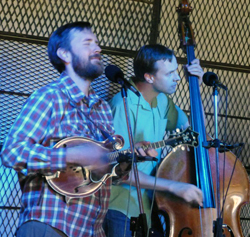
I think it’s a brilliant concept—it’s all you need for live multitrack recording, and no more, so it’s very affordable. Compared to a multitrack hard-drive recorder, the Tracker is much easier to carry and has no moving parts to fail.
We used it to record the fourth gig. I plugged TRS phone-to-phone cables between the mixer’s insert jacks and the Tracker’s line inputs.
Then I set recording levels using the mixer’s gain trim knobs. This also resulted in correct gain staging in the mixer.
The Tracker lacks meters but it does have a clip LED for setting levels. If any of the inputs is clipping, that single LED flashes, so during the gig, you need to watch the mixer to indentify any clipping channels.
I simply tapped five buttons to arm the tracks, then hit record. It recorded the show flawlessly.
Back in the studio, I inserted the SD card in my computer and copied the wave files to the hard drive for mixing in a DAW.
How did it sound?
Here is a sample of the finished mix: Multitrack mix
Here are the soloed tracks: Guitar soloed
Bass soloed (there is some compression on this track to make the attack more punchy):
And, here’s an A-B comparison between a PreSonus Studio Project audio interface and a Behringer UB2222FX-Pro mixer insert into the JamHub Tracker M16. I recorded a guitar with one Neumann KM-184 mic, Y’d into both devices.
These are 16-bit/44.1kHz wave files:
We learned a lot from this process. Generally the sound improves as the miking and recording techniques become more complex. When we went from two mics at a distance to six mics close-up, the recorded background noise dropped, the gain-before-feedback increased, and the mix balance improved.
When we went from a stereo board mix to a multitrack recording and mixdown, the mix balance improved again. Also the EQ for each instrument was better because the monitoring was done in a quiet studio with loudspeakers instead of in a noisy venue with headphones.
The moral of the story: get all of the equipment you need to do the job right.
Bruce Bartlett is a recording engineer, live sound engineer, audio journalist and microphone engineer (www.bartlettaudio.com). His latest books are Practical Recording Techniques 6th Edition and Recording Music On Location 2nd Edition.
